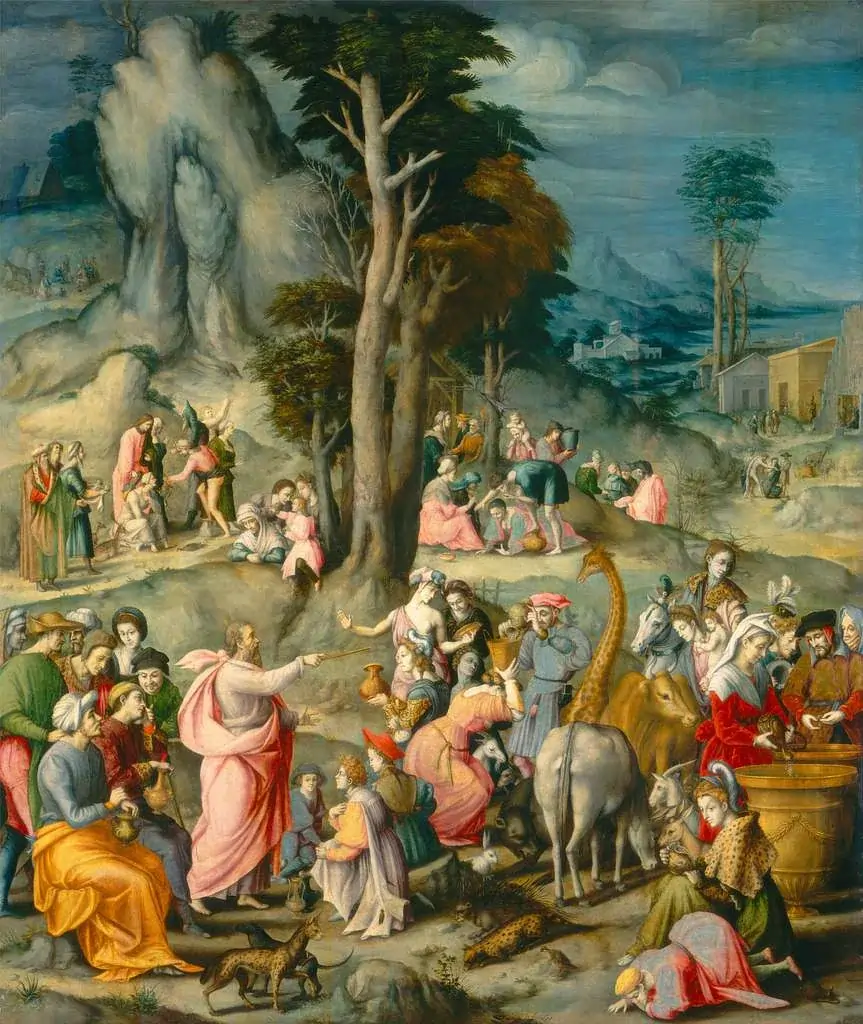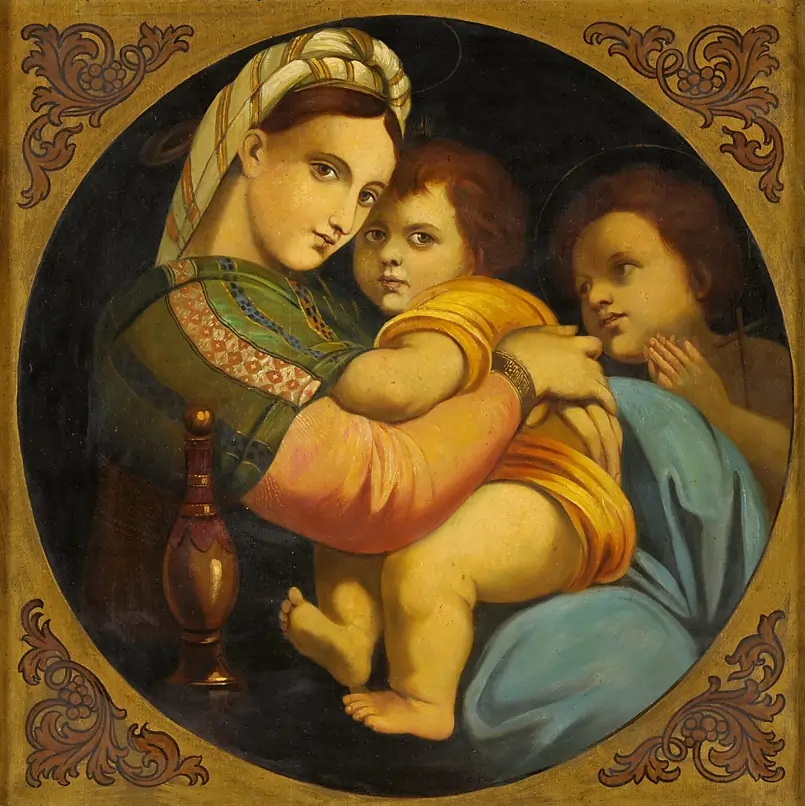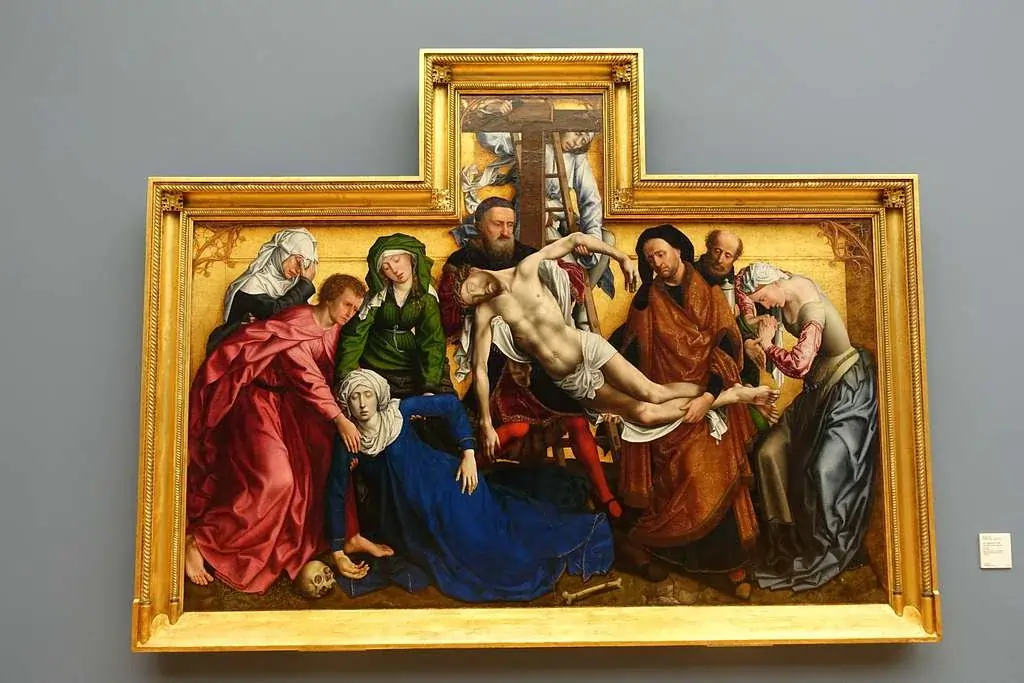In front of Bacchiacca’s painting ‘The Gathering of Manna’ I am amazed, at how this artwork depicts a moment from the Bible with a touch of Renaissance elegance. The scene where manna is being gathered is illustrated on the panel with precision. Reveals the artists distinct perspective, on this extraordinary event.
The captivating allure of this painting pulls us in with its arrangement of figures gracefully moving across a crafted landscape. As someone well versed in art history I’ve delved into portrayals of events yet Bacchiacca’s unique Mannerist style distinguishes this piece with its rich palette, intricate positioning of figures and meticulous focus, on details.
Let’s delve into the background of this masterpiece and dissect how it was created technically and explore the elements that define it as a notable representation of Florentine Mannerism style artistry. The journey of this piece, from collections to its residence, at the National Gallery will also be traced.
Historical Context and Creation
Bacchiacca’s evolution, in the art scene of Florence captivates me greatly.
I am intrigued by how he forged his identity under the tutelage of Perugino and blended Renaissance traditions with fresh Mannerist elements, unlike his peers who fully embraced the dramatic flair of Mannerism.
In 1540 a significant moment occurred when he was appointed to the court of Duke Cosimo I de’ Medici which positioned him within Florence’s circle collaborating with renowned personalities such, as Pontormo and Bronzino on notable projects, like decorating the dukes private study with intricate botanical and animal drawings that highlighted his exceptional attention to detail in observing nature.
During a period, at the Medici court, between 1540 and 1555 Bacchiacca crafted ‘The Gathering of Manna’ showcasing reflections of his artistic inspirations.
- The balanced composition learned from Perugino
- Northern artistic elements from Albrecht Dürer
- Mannerist techniques observed from Pontormo
- Classical influences derived from Michelangelo
Bacchiacca’s distinctive technique has always fascinated me. The way he merges figures, with costumes and diverse patterns to craft compositions is truly captivating in his gathering painting.
Bacchiacca stood out from his peers due, to his skill, in blending intricacy with the grandeur of the Renaissance in a seamless manner that I find truly remarkable. His unique blend of artistry resonated well with his supporters who valued both Italian artistic influences. During the 1540s as he worked on pieces like ‘The Gathering of Manna’ he started incorporating more traditional classical elements inspired by Michelangelo’s work – showcasing his versatility as an artist.
Technical Analysis of the Painting
Looking closely at the technical aspects of ‘The Gathering of Manna’, I’m amazed by the masterful execution on what appears to be a perfectly preserved oil on panel work. The painting’s impressive dimensions of 111.8 x 95.3 cm create an engaging visual experience, while its framed measurements of 141 x 123.2 x 8.3 cm add a commanding presence to its display.
Oil on Panel Technique
As I inspect the surface of the painting closely I can see how Bacchiacca skillfully used oil paint, on the panel. This selection of material was not arbitrary. During the Renaissance era artists often favored panels for their surface, which suited the intricate details present in this particular artwork. Dating back, to the years 1540 to 1555 this piece highlights Bacchiacca’s expertise that earned him prestige among his artists from that time period.
Color Palette and Composition
Bacchiacca’s unique use of colors really makes his work stand out from others of the period that I’ve examined before – his creative color pairings are truly remarkable and catch my eye every time I see them:
- Traditional Renaissance harmonies
- Bold Mannerist color experiments
- Subtle environmental tones that unite the composition
Conservation and Condition
Being a part of the Samuel H. Kress Collection gives me confidence, in saying that the painting has been well taken care of over the years. The current state reflects the longevity of the oil on panel method and the meticulous preservation work done through time. The sturdy wooden backing has played a role, in preserving the paint layers integrity and showcasing Bacchiacca’s skill as originally intended.
Artistic Elements and Style
Upon analyzing ‘The Gathering of Manna’ I am fascinated by Bacchiacca’s fusion of inventive techniques, in his artistic presentation.
Figure Composition and Arrangement
In analyzing the artworks structure closely I can see the setting Bacchiacca portrays, with arranged characters in the painting showing a woman balancing a basket on her head and a young man lugging a sizable amphora alongside a youth carrying a basket at his side The aspect that intrigues me the most is his ability to uphold the Renaissance notion of harmony, amidst integrating Mannerist advancements in his packed compositions.
Landscape and Environmental Details
Bacchiacca’s attention, to detail in the surroundings is evident in the paintings setting. I admire his use of animals and intricate botanical elements which he honed during his time in the dukes study. The scenery doesn’t just serve as a background; it plays a role, in enhancing the story of this biblical scene.
Mannerist Characteristics
The painting exemplifies key Mannerist features that set Bacchiacca apart from his contemporaries:
- Playful distortions of Renaissance rules while maintaining underlying order
- Creation of ambiguous, subjective space characteristic of Mannerism
- Eclectic combination of figures and exotic costumes
- Unusual color combinations that became his trademark
It’s amazing how Bacchiacca drew inspiration from artists, like Albrecht Dürer and Marcantonio Raimond into his work by combining Flemish and Italian Renaissance styles that appealed to his patrons.
Provenance and Exhibition History
The tale of ‘The Gathering of Manna passage, through history unveils a captivating narrative of possession and conservation. The paintings recorded past commences, with Stefano Bardini renowned Florentine art dealer who possessed it in his assortment by 1899.
Journey through Collections
I find it particularly interesting how the painting changed hands through several notable sales. After Bardini’s initial attempt to sell at Christie’s London, the work eventually made its way to New York, where H.L. Kaufman acquired it through the American Art Association in 1918. The painting then passed through several distinguished galleries, including Pinakos Inc., before being jointly handled by Frederick Mont, Victor D. Spark, and M. Knoedler & Co.
Notable Exhibitions
The gathering painting’s exhibition history includes several significant showings:
- Roosevelt House at Hunter College, New York (1944)
- “Recent Additions to the Kress Collection” at the National Gallery of Art (1946)
Current Home at National Gallery
What I consider most significant in the painting’s journey is its acquisition by the Samuel H. Kress Foundation on August 6, 1943. The Foundation’s generous gift in 1952 brought this masterpiece to its permanent home at the National Gallery of Art, where it currently resides in the West Building’s Main Floor – Gallery 20.
Today, I can tell visitors that this remarkable work carries the accession number 1952.5.4, marking its place in one of America’s most prestigious art collections. The painting’s journey from private collections to public display represents what I see as a perfect example of how great artworks eventually find their way to spaces where they can be appreciated by all.
Conclusion
His exceptional piece highlights his craftsmanship with oil painting techniques, on panels and thoughtful selection of colors along with intricate arrangement of figures in the composition. The elegance of the artwork reflects his experience at the Medici court. Is evident in its aesthetics which are further enhanced by a diverse range of artistic inspirations ranging from Perugino, to Dürerto enrich its visual expression.
Upon reviewing this artwork I am reminded of why it holds a spot, in the National Gallery’s collection of treasures. With preservation and thoughtful presentation over time contemporary viewers can now admire the details and artistic brilliance that originally fascinated Bacchiacca’s patrons in Florence. This captivating painting not depicts a miracle but also encapsulates the essence of artistic progress during one of the most vibrant eras, in art history.
FAQs
Q1. Who was Bacchiacca and what is his significance in Renaissance art? Bacchiacca was a Florentine artist who played a unique role in the transition between Renaissance and Mannerist styles. He was known for his eclectic approach, blending traditional techniques with innovative elements, which made his work particularly appealing to courtly patrons.
Q2. What makes ‘The Gathering of Manna’ a notable painting? ‘The Gathering of Manna’ is notable for its complex composition, unusual color combinations, and intricate details. It showcases Bacchiacca’s ability to blend Renaissance principles with Mannerist innovations, creating a visually striking interpretation of a biblical scene.
Q3. How did Bacchiacca’s artistic style differ from his contemporaries? Bacchiacca’s style was characterized by a unique fusion of Flemish detail and Italian Renaissance grandeur. He incorporated exotic elements, diverse motifs, and unconventional color choices while maintaining a balance between traditional and innovative techniques.
Q4. What techniques did Bacchiacca use in creating ‘The Gathering of Manna’? Bacchiacca used oil on panel technique for this painting, which allowed for durability and fine detail. He employed a distinctive color palette and carefully arranged figures to create a bustling scene, incorporating both Renaissance balance and Mannerist complexity.
Q5. Where can one view ‘The Gathering of Manna’ today? ‘The Gathering of Manna’ is currently housed in the National Gallery of Art in Washington, D.C. It can be found in the West Building’s Main Floor – Gallery 20, where it has been on display since its acquisition by the museum in 1952.



